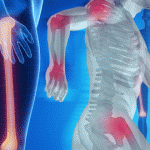Soft-Tissue Sources
Most low back pain cases involve a soft-tissue source, including mechanical enthesitis, such as ligament sprains, tendinitis or fasciitis, and bursitis and cutaneous nerve entrapments. These conditions may be acute or chronic. Sprains, tenderness or injuries to soft tissues of the entheses are common culprits for low back pain, including three in particular: iliolumbar ligament/thoraco-lumbar fascia (TLF) complex enthesopathy, sacrotuberous ligament/TLF complex enthesopathy and paraspinous process enthesopathy, involving the fascial attachments of the multifidus, erector spinae and the thoracolumbar
fascia, Dr. Gillies said.
Using diagrams, Dr. Gillies explained how to examine tender, soft-tissue sources of a patient’s low back pain: With the patient lying on their abdomen, palpate and mark the top of the iliac crests, followed by the inferior border and lateral border of the posterior superior iliac spine (PSIS). Then, palpate and mark the outline and border between the ilium and sacrum, and down the lateral border of the sacrum.
“These are the really common sites. When you go back to your office and someone has low back pain, have them lie face down and then press on these places: the medial iliac crest, the ilio-lumbar ligament, the side of the PSIS, and the paraspinous process entheses at S1 or S2.” Most patients react strongly to pressure at the source of their tenderness or pain, she said.
A specific source of back pain may be established in most cases, often due to mechanical enthesitis, said Dr. Gillies. Her opinion was influenced by a 1991 study showing 60% of patients who presented to an outpatient rheumatology clinic in the U.K. with low back pain had tenderness on palpation at the medial end of their iliac crests.7
Later, she treated a 48-year-old man with a 24-year history of low back pain and sciatica who presented with intermittent right buttock and right posterior thigh pain. “He had no constant pain, which is always good. I always say, if pain is intermittent, this should be treatable, because at times, it doesn’t hurt,” she said.
After palpation, she found his pain was not at the medial end of the iliac crest, but was very localized in an area the size of a can of tuna, and exacerbated by lifting. His back pain stemmed from an injury he sustained 25 years earlier while cross-country running.
He minimized his lifting activities in his veterinary work to manage his on-and-off pain. “He didn’t have any morning stiffness, but his maximum driving time was an hour, and then he’d have to stop and get out. He was constantly shifting when standing or sitting. Walking for him was unlimited and helped.”
Her patient had exquisite tenderness on the lateral crest of his PSIS. Dr. Gillies injected 10 cc of bupivacaine 0.25% into the ilial fibers of the proximal attachment of the right sacrotuberous ligament to confirm the site of his pain. “Bupivacaine lasts about five hours. If they’re pain free when they leave, and the pain comes back after exactly that amount of time, it’s an obvious diagnosis. But don’t tell them how long the medication lasts,” she said.
Her patient had no pain on his hour-long drive home, but his pain returned five hours later, as she expected. She then treated him with four injections every two weeks of 2 cc of triamcinolone (20 mg) and 3 cc of bupivacaine (0.25%), which eliminated his pain over the next year-and-a-half—except for one self-limiting episode after lifting a heavy box.
Although back pain from cutaneous nerve entrapment is less common, perineural injection treatment (PIT), or neural prolotherapy, of buffered dextrose 5% (D5W) around the swollen cutaneous nerves may be performed in the office to diagnose this cause within just 10 minutes, and it has no adverse effects—an approach studied in a 2016 case series of patients with medial superior cluneal nerve entrapment, said Dr. Gillies.8 A sports medicine specialist in New Zealand, John Lyftogt, MD, has used neural prolotherapy to rapidly relieve pain and restore mobility in low back pain patients, she said.9

